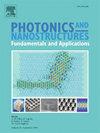Unlocking Cesium based new double absorber perovskite solar cells with efficiency above 28 % for next generation solar cell
IF 2.5
3区 物理与天体物理
Q3 MATERIALS SCIENCE, MULTIDISCIPLINARY
Photonics and Nanostructures-Fundamentals and Applications
Pub Date : 2025-03-01
DOI:10.1016/j.photonics.2025.101371
引用次数: 0
Abstract
The limited photon absorption capacity of single-active-layer perovskite solar cells (PSCs) restricts their efficiency and scalability for future photovoltaic applications. This study introduces an innovative double perovskite active layer (DPAL) design, incorporating CsSnI3 and CsPbI3, along with a cadmium sulfide (CdS) electron transport layer (ETL), to overcome these challenges. Using the SCAPS-1D simulation tool, we demonstrate that this novel configuration significantly improves performance, achieving a power conversion efficiency (PCE) of 28.74 %, an open-circuit voltage (VOC) of 0.996 V, a short-circuit current density (JSC) of 34.94 mA/cm², and a fill factor (FF) of 82.61 %. These results surpass the efficiencies of single-active-layer designs, which reach 17.84 % for CsPbI3 and 24.08 % for CsSnI3. The study further explores the influence of active layer thickness, defect density, and interface defect densities on solar cell performance, along with the effects of doping concentration, series and shunt resistance, and temperature on PCE. This research highlights the potential of DPAL-based PSCs as a promising approach for achieving high-efficiency, stable, and cost-effective solar energy solutions.
为下一代太阳能电池解锁效率在28% %以上的铯基新型双吸收钙钛矿太阳能电池
单活性层钙钛矿太阳能电池(PSCs)有限的光子吸收能力限制了其在未来光伏应用中的效率和可扩展性。本研究引入了一种创新的双钙钛矿活性层(DPAL)设计,结合CsSnI3和CsPbI3,以及硫化镉(CdS)电子传输层(ETL),以克服这些挑战。利用scps - 1d仿真工具,我们证明了这种新型配置显著提高了性能,功率转换效率(PCE)为28.74 %,开路电压(VOC)为0.996 V,短路电流密度(JSC)为34.94 mA/cm²,填充因子(FF)为82.61 %。这些结果超过了单活性层设计的效率,CsPbI3达到17.84 %,CsSnI3达到24.08 %。该研究进一步探讨了有源层厚度、缺陷密度和界面缺陷密度对太阳能电池性能的影响,以及掺杂浓度、串联和并联电阻以及温度对PCE的影响。该研究强调了基于dpal的PSCs作为实现高效、稳定和具有成本效益的太阳能解决方案的有前途的方法。
本文章由计算机程序翻译,如有差异,请以英文原文为准。
求助全文
约1分钟内获得全文
求助全文
来源期刊
CiteScore
5.00
自引率
3.70%
发文量
77
审稿时长
62 days
期刊介绍:
This journal establishes a dedicated channel for physicists, material scientists, chemists, engineers and computer scientists who are interested in photonics and nanostructures, and especially in research related to photonic crystals, photonic band gaps and metamaterials. The Journal sheds light on the latest developments in this growing field of science that will see the emergence of faster telecommunications and ultimately computers that use light instead of electrons to connect components.

 求助内容:
求助内容: 应助结果提醒方式:
应助结果提醒方式:


